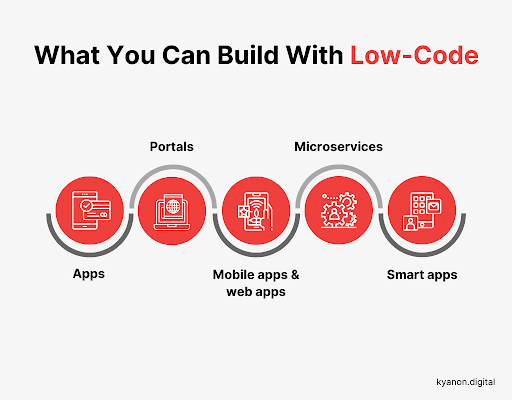Top Facts On Picking Legacy application modernization with Low-code
Top Facts On Picking Legacy application modernization with Low-code
Blog Article
The Advantages Of Low-Code Development For Speed
Visual Development Environment :
Drag-and-Drop Interfaces: Low-code platforms provide visual tools for designing applications. Drag-and-drop tools allow developers to quickly build applications without having to write code.
Many low-code platforms have built-in templates and components that permit developers to quickly prototype applications and then build them without having to start with a blank slate.
Reducing Coding requirements
Automated Coding Generation: Low code platforms generate code automatically based on the visual model developed by the developers. It reduces the need to code manually and accelerates development.
Reusable components: Developers are able to reuse components across multiple projects, which reduces the amount of time they spend creating and evaluating code.
Collaboration can be made easier.
Integrated Development Tools: Low-code platforms typically contain tools for managing versions as well as testing and deployment that allow seamless collaboration between development teams.
Citizen Development (Citizen Development): Users and non-developers of business applications can participate in application development by making use of intuitive interfaces. This reduces the bottleneck caused by the limited accessibility of professional developers.
Rapid Iteration, Prototyping
Fast prototyping: Developers can create prototypes quickly to validate ideas and collect feedback. This leads to less time spent on iterations.
Simple Modifications: The visual design of low-code programming makes it simpler to make changes and updates to applications. This speeds up the process of refining and improving applications based on user feedback.
Pre-built Integrations:
API Integrations. Low-code platforms typically come with pre-built connectors as well as APIs for popular services which can reduce the amount of time required to integrate with other systems.
Data Integration: The tools that are built in the software make it easier and speed up the process of connecting databases, other data sources and applications.
Scaling, deployment and deployment
One-Click-Deployment: Many Low-Code platforms offer one click option for deployment. This cuts down on the amount of time and effort required to set up an application.
Cloud-based solutions: Cloud low-code platforms are capable of scaling and infrastructure management. Developers can concentrate on functionality and logic of the application rather than deployment logistic.
In general, low-code development has the advantage in terms speed due to its capacity of automating and simplifying many aspects of development. This allows for quicker delivery of apps and easier adaptation to changing needs. Check out the top rated Low-code Platform for application development advice for blog recommendations including cross platform mobile development, develop web application, app modernization, azure sql databases, low code development platforms, cross platform mobile app development, push notifications android, sso azure, software for app development, develop web application and more.
Cost-Effectiveness Is Among The Many Benefits Of Creating Applications With Low-Code.
The low-code approach to app development is a cost-effective solution that has many benefits. It's an excellent choice for companies who want to make the most of their budgets and deliver high-quality apps. The main benefits are reduced costs for development:
The low-code platform makes it less necessary to write extensive manual coding. This means less time and effort on the part of developers when developing applications. Also, it means less cost of labor.
Reduced Developer Resources: Because low-code is quicker and easier to create, less skilled developers will be needed. This will drastically lower the cost of hiring and staffing.
Speedier Time to Market
Accelerated Development Cycle: The visual development tools and pre-built components offered by low-code platforms allow for rapid application development, which allows businesses to bring products to market faster. This could lead to faster revenue growth and improve your position in the marketplace.
Rapid prototyping allows businesses to build prototypes and test them in a very short amount of time, which reduces the amount of time required for the development phase. This lets them make quicker the next iteration after receiving feedback from users.
Low Maintenance Costs
Because of their modular architecture and standardised components, low-code platforms usually make it easier to maintain applications. This reduces maintenance and support costs.
Automated Updates: Many low-code platforms can handle patches and updates in a way that is automatic, ensuring applications remain secure and up-to-date without requiring extensive manual intervention.
Efficient Resource Utilization:
Low-code platform contributions allow both business users and other non-developers to participate in the process of creating. This is a way for developers to be more democratic and allows businesses and employees to collaborate, thereby reducing the dependency on high-paid developers.
Improved utilization of IT resources IT departments are given the chance to concentrate on more strategic initiatives, instead of being bogged-down with mundane development tasks. Overall efficiency and productivity are improved.
The Scalable Pricing model
Subscription pricing: A lot of low-code platforms offer flexible pricing plans for subscriptions that can be scaled according to usage. This lets companies adjust their budgets according to their needs and growth without the need to incur large upfront cost.
Pay-Assosiated Alternatives: Some platforms provide pay-assosiated choices. These ensure that businesses are only liable for the services used and are beneficial for small and new businesses that have limited resources.
Reduced costs of third-party software:
Low-code platforms are built-in with functionality and integrations that could reduce the cost of software subscriptions and licensing.
Pre-Built Integrations: Having of pre-built integrations to popular services and systems reduces custom development. Time savings and money.
Better ROI
A faster return on investment (ROI) by making use of the rapid development process, less expense and a quicker time to market, businesses can get an increase in ROI for their applications.
Enhanced Agility - Companies are able to swiftly adjust to changes in the market and to changing customer demands. This lets them stay relevant and capitalize on opportunities that come up.
Low-cost Training:
User-Friendly Interfaces: Low code platforms are user-friendly and have simple interfaces, which reduces the learning curve.
Accessible Resources: Many low-code platforms offer comprehensive instructional materials, tutorials and community support, further lessening the requirement for formal education and associated costs.
Collaboration streamlined:
Collaboration Tools: Collaboration tools integrated aid in coordination and communication within teams, leading to better process for development and reduced cost of operations.
Unified Development Environment : A unified environment simplifies work flows and cuts down on the expenses of managing multiple tools and platforms.
The efficiency of low-code application development lies in its ability to reduce development and maintainance costs, accelerate the time to market, improve resources, and offer different pricing options. These factors combine to deliver substantial financial benefits to businesses, making low-code a compelling choice for organizations aiming to maximize their development budgets while achieving robust, scalable and top-quality applications. View the most popular she said about Legacy application modernization with Low-code for more examples including no code platforms, azure sql, mobile development platforms, driver jdbc, jdbc server, rapid app development, app platforms, rapid applications, application development platforms, database in azure and more.
Advantages Of Low-Code Application Development In Terms Of Collaboration And Workflow
Low-code application development is a great option for businesses looking to improve team efficiency by streamlining development processes. These are the main advantages.
Unified Development Environment (UDE): Low code platforms create a single, unified development environment that allows all team players such as developers and business analysts to collaborate effectively. This helps to eliminate silos and promotes better communication.
Visual Development Tools - The drag-and drop visual nature of low-code platforms allows for non-technical staff to take part in the development process. This ensures that the requirements of business are identified and accurately implemented.
Communication Enhancement
Real-Time Collaboration: A lot of low-code platforms offer real-time collaboration capabilities like the simultaneous editing of comments, and instant feedback. These features facilitate continuous communication and reduce the time spent on back-and-forth discussions.
Workspaces shared by teams. Teams can collaborate in shared workspaces. Here, they can see, edit, and debate various project elements.
Streamlined workflow management:
Integrated Project Management Tools: Many low-code platforms have integrated tools for managing projects that can help teams track and organize their projects for development. This includes task assignments, progress tracking, and deadline management.
Workflow Automation: Automation of repetitive tasks and workflows can reduce errors and manual labor, allowing teams to focus on more strategic tasks and enhancing overall efficiency.
Faster Iteration Cycles:
Rapid Prototyping : Low-code platforms allow rapid prototyping. They also allow iterative and rapid development. This allows teams to develop apps, test them and refine them in shorter periods of time. This allows for quick feedback and improvement.
Agile Development Support Agile Development Support: Support for agile methods lets teams work in sprints, continually offering small increments of functionality and making it easier to adjust to changing requirements.
Accessibility of Non-Developers
Citizen Development: Low-code platforms enable business users (citizen developers) to design and develop applications without requiring a lot of coding experience. This eases the workload on IT teams as well as developers, enabling them to react more quickly to business demands.
Onboarding and training: The intuitive user interfaces and extensive resources for training help bring new members of the team up to level. This helps improve overall collaboration in the team.
Centralized documentation knowledge sharing, dissemination and documentation:
Low-code platforms usually include features for creating, maintaining and storing documents within their platform. This lets all the project information to be stored centrally and accessible easily.
Knowledge Repositories: Teams can build knowledge repositories that include templates, best practices, and reused components. This helps in sharing knowledge and minimizes the need for duplicate efforts.
Consistency and Standardization
Standardized Components. Utilizing standard components that are pre-built allows for uniformity throughout all software. This helps team members learn and collaborate with various parts of projects.
Governance and Compliance - Built-in governance frames ensure that the development process of all applications conforms to the organizational standards as as the regulatory guidelines. This helps reduce non-compliance risk and assures that applications comply with the highest quality standards.
Feedback Loops and Improvement Loops
Integrated Feedback Mechanisms Low-code platforms usually have integrated feedback mechanisms, allowing users to easily give feedback to applications. This can later be integrated into the process of development.
Continuous Improvement: The capability for software to rapidly iterate and make changes on the basis of feedback, while ensuring they are closely aligned with the requirements of the user as well as business objectives.
Reporting and visualization:
Real-Time Analysis Tools for reporting and analytics built into the software provide real-time insights on project progress as well as user interactions and performance. This enables the use of data to make decisions.
Visual Workflow Mapping: Visual tools for mapping workflows and processes help teams comprehend and optimize their workflows, identifying the areas of improvement and bottlenecks.
Overall, the advantages of developing low-code applications in terms of collaboration and workflow lie in its capacity to bring together diverse teams, streamline communication, and streamline processes. This results in a more efficient, flexible and efficient development environment, which leads to more efficient and high-quality applications.